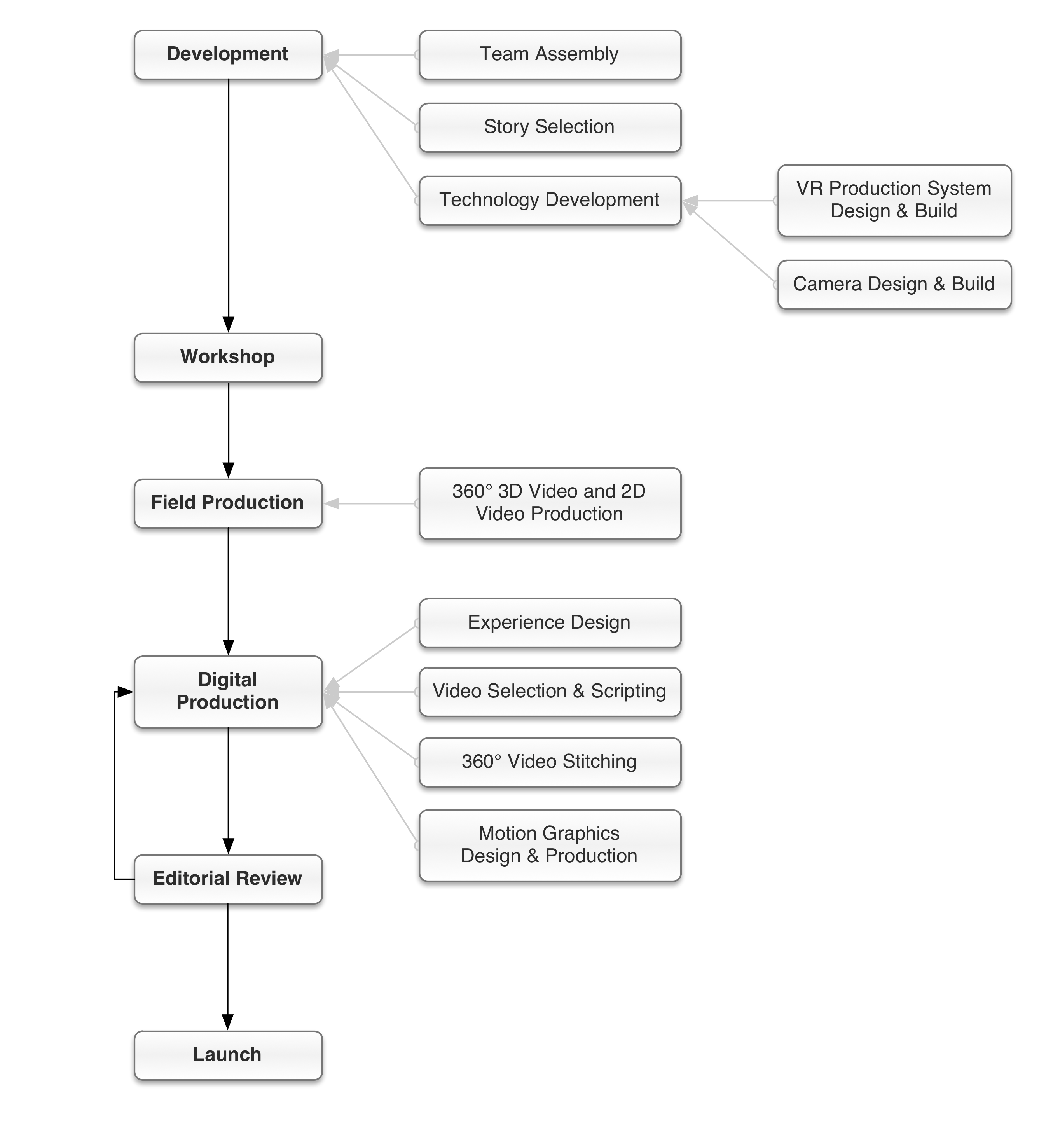Project Design
Looking to test both the technical practicalities and potential of VR journalism, we produced a virtual reality documentary on the Ebola outbreak in Sierra Leone, Guinea, and Liberia. Director Dan Edge was already producing a feature documentary for Frontline on the topic and agreed to take on the additional project. What follows is a detailed breakdown of the VR production experience.
Rationale
This research project comes at a time when virtual reality’s value for journalism is largely hypothetical. The industry desperately needs evidence of the platform’s benefits and information about the necessary skills, practices, and equipment.
The industry has only produced a few works of journalism in live-motion virtual reality (The New York Times’s “Walking New York,” the BBC’s Calais “Jungle,” Gannet’s “Harvest of Change,” and Vice News’s “Millions March” and “Waves of Grace”). The Associated Press, Gannet, Vice News, Fusion, and The New York Times have all made major commitments to developing journalism in virtual reality. The context and theories described in the preceding chapters suggest that immersive experiences can engender feelings of presence, producing higher levels of engagement (and perhaps empathy), and give audiences enhanced spatial understanding. However, without multiple examples, the industry is unable to make a judgment about whether the hypothesized value is real.
The next step in assessing VR’s potential within journalism is to understand what is involved in producing the work—a necessity for journalists who want to make virtual reality content, strategists who need to judge the viability of the medium for their own circumstances, and innovators who intend to improve the processes and outcomes.
This case study, we believe, contributes to the knowledge base on these high-level topics, illustrating how virtual reality can be valuable for journalism, as well as chronicling the processes and resources that are involved technically, conceptually, and editorially.
The writing below represents the observations of our core research team about the process of producing a piece of live-motion virtual reality journalism. Taylor Owen and Fergus Pitt had access to all stages of the editorial and development process, and to technical documents, communications between project teams, and project iterations at all points of evolution. The information in the case study therefore draws on the researchers’ observations of key workshops and meetings, structured interviews with team members during the production process, email exchanges, and reviews of technical documents. Raney Aronson-Rath and James Milward, along with their respective teams, both reviewed and contributed to the case study. Readers should note that the authors are not objective observers; Fergus Pitt and Taylor Owen contributed money from the Tow Center’s research fund and the Knight Foundation’s prototype fund that paid for camera equipment and some of Secret Location’s production effort.
Roles and Teams
Below we document the main players involved in producing virtual reality journalism. It omits a number of people, including some who temporarily substituted into roles, or who contributed back-office efforts. Also, this project leveraged elements of Frontline’s traditional television documentary resources, including considerable journalistic research and production planning. Those contributions are not included below. The full credit list for the production is available in the appendices of this report.
Raney Aronson-Rath, Executive Producer, Frontline—editorial development, story selection, commissioning, editorial oversight.
James Milward, Executive Producer and Founder, Secret Location—project development, virtual reality domain knowledge.
Dan Edge, Director and Producer, Frontline and Mongoose Production—360-degree video and sound recording, direction, scripting.
Luke Van Osch, Project Manager, Secret Location—project management, VR technology documentation and training.
Preeti Gandhi, Producer, Secret Location—creative production, project management, VR post production, technology-build supervision.
Michael Kazanowski, Motionographer, Secret Location—360-degree camera and post-production technology development, 360-degree video stitching, immersive video authoring.
Steve Miller, Motionographer, Secret Location—360-degree camera and post-production technology development.
Taylor Owen, Assistant Professor of Digital Media and Global Affairs, University of British Columbia—project development, research, documentation, and report drafting.
Fergus Pitt, Senior Research Fellow, Tow Center for Digital Journalism—project development, research, and documentation, and report drafting.
Pietro Gagliano, Creative Director, Secret Location—digital concept direction.
Andy Garcia, Art Director, Secret Location—motion graphics design and production.
Sarah Moughty, Managing Editor of Digital, Frontline—editorial and production liaison.
Process
The project moved through stages of development, field production, digital-production, and distribution.
While the diagram below shows—at a high level—those stages, more importantly it shows the component tasks. It is simplified and focuses on the VR-specific processes. As such, it omits important aspects of journalistic reporting and research, and many business and operational support contributions without which any production would fail. As with most models, this one sacrifices precision for simplicity. In reality, stages overlapped; some steps were repeated, and the team went backwards and forward through the phases.
